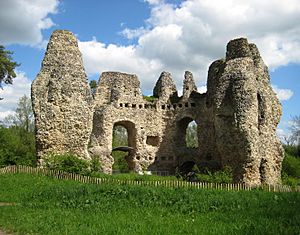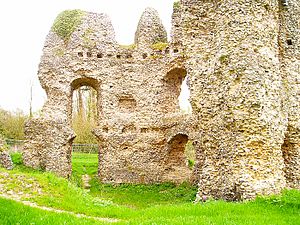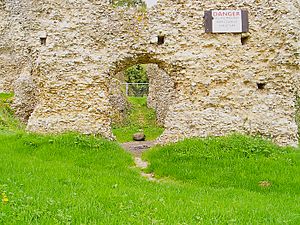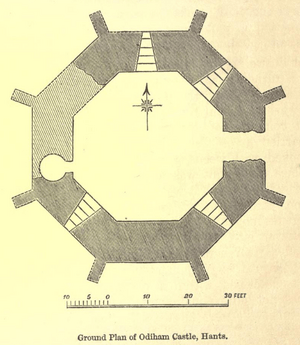Odiham Castle facts for kids
Quick facts for kids Odiham (King John’s) Castle |
|
|---|---|
| North Warnborough, Hampshire, England | |

Ruins of Odiham (King John’s) Castle.
|
|
| Type | Shell keep with outer bailey |
| Height | Up to 9 metres (30 ft) |
| Site information | |
| Owner | Hampshire County Council |
| Open to the public |
Yes |
| Condition | Ruin |
| Site history | |
| Built | 1207–1214 |
| Built by | King John |
| In use | Until mid 16th century |
| Materials | Flint Lime Mortar Timber |
| Battles/wars | First Barons' War |
| Events | Hosted Parliament in the 13th Century Prison of Scottish King David II |
Odiham Castle, also known as King John's Castle, is a cool ruined castle in Hampshire, England. It's special because it's one of only three castles that King John built during his time as king! King John might have picked this spot because he visited the area in 1204. It was also a perfect halfway point between his castles at Windsor and Winchester.
Contents
Building Odiham Castle
Odiham Castle was built on about 20 acres of land. This land was bought from a local lord named Robert the Parker. To make the castle even stronger, a bend in the River Whitewater was changed to help with its defenses.
The castle took seven years to build, from 1207 to 1214. It had a tall, three-story stone tower called a keep. There was also a round moat (a water-filled ditch) inside and a square moat outside. The castle also had two other areas called baileys, which were also surrounded by moats. To make it even safer, there were raised earth banks and wooden fences called palisades. The castle even had a special building called a domus regis, which means 'king's house'.
Records show that building the castle cost about £1,000 between 1207 and 1214. That's like spending over £1.5 million today!
Castle History
In 1215, King John rode from either Odiham or Windsor to a place called Runnymede. There, he met with powerful barons and signed a very important document called the Magna Carta. This document limited the king's power.
Just a year later, in 1216, Odiham Castle was attacked by French forces during a conflict called the First Barons' War. The French laid siege to the castle for two weeks. The small group of just 13 defenders had to give up on July 9, 1216. After the French left, the castle's main tower was fixed up, probably because it was damaged during the attack. Some people think the mound the tower sat on was made 5 meters taller around this time. An inner moat around the tower was also likely added for more protection.
Royal Connections
In 1238, Simon de Montfort married Eleanor, who was King John's daughter. Eleanor had been given Odiham Castle by her brother, King Henry III, two years earlier. During this time, a kitchen was built on a bridge over the inner moat. A new hall was also added outside the main tower. Another building was put up over the moat to give more living space.
Later, in 1263, Simon de Montfort rebelled against King Henry III. Simon died in a battle in 1265, and Eleanor had to leave the country. Odiham Castle then went back to being owned by the Crown (the king or queen).
The castle was also involved in another rebellion. This one was led by the powerful Despenser family against Roger Mortimer and Queen Isabella of France, who was married to King Edward II.
A Royal Prison
Odiham Castle was important enough to host the Parliament at least once, in 1303. It also served as a prison for a very important person: King David II of Scotland. He was captured in 1346 during the Battle of Neville's Cross. He was held at Odiham for 11 years! He had a light guard and was even allowed to have his own household. Using the castle as a prison was common in the 13th and 14th centuries.
By the 15th century, Odiham Castle was mostly used as a hunting lodge. By 1605, it was described as a ruin. In 1792, the Basingstoke Canal was built right through the southern part of the castle grounds.
Protecting the Castle Today
Odiham Castle is open for everyone to visit! The only parts you can still see are some of the octagonal (eight-sided) main tower and the earthworks (mounds and ditches) around it. In 2007, Hampshire County Council worked to restore the main tower with help from English Heritage. A small, overgrown pond on the other side of the canal is all that's left of the castle's southernmost moat.
Archaeologists have dug at the castle twice. Once in 1953, and then again between 1981 and 1985. These digs helped us learn more about the castle's past.




